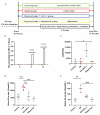Priestia megaterium ASC-1 Isolated from Pickled Cabbage Ameliorates Hyperuricemia by Degrading Uric Acid in Rats
- PMID: 38674776
- PMCID: PMC11052324
- DOI: 10.3390/microorganisms12040832
Priestia megaterium ASC-1 Isolated from Pickled Cabbage Ameliorates Hyperuricemia by Degrading Uric Acid in Rats
Abstract
Pickled cabbage, a traditional fermented food rich in functional microorganisms, can effectively control hyperuricemia and gout. In this study, a Priestia megaterium ASC-1 strain with strong uric acid (UA) degradation ability was isolated from pickled cabbage. After oral administration for 15 days, ASC-1 was stably colonized in the rats in this study. ASC-1 significantly reduced UA levels (67.24%) in hyperuricemic rats. Additionally, ASC-1 alleviated hyperuricemia-related inflammatory response, oxidative stress, and blood urea nitrogen. Intestinal microbial diversity results showed that ASC-1 restored intestinal injury and gut flora dysbiosis caused by hyperuricemia. These findings suggest that P. megaterium ASC-1 may be used as a therapeutic adjuvant for the treatment of hyperuricemia.
Keywords: Priestia megaterium; gut microbiota; hyperuricemia; uric acid.
Conflict of interest statement
Siyuan Bi was employed by the Shenzhen Jinyue Test Technology Co., Ltd. The remaining authors declare that the research was conducted in the absence of any commercial or financial relationships that could be construed as a potential conflict of interest.
Figures





Similar articles
-
Limosilactobacillus fermentum JL-3 isolated from "Jiangshui" ameliorates hyperuricemia by degrading uric acid.Gut Microbes. 2021 Jan-Dec;13(1):1-18. doi: 10.1080/19490976.2021.1897211. Gut Microbes. 2021. PMID: 33764849 Free PMC article.
-
Lacticaseibacillus paracasei JS-3 Isolated from "Jiangshui" Ameliorates Hyperuricemia by Regulating Gut Microbiota and iTS Metabolism.Foods. 2024 Apr 29;13(9):1371. doi: 10.3390/foods13091371. Foods. 2024. PMID: 38731742 Free PMC article.
-
The anti-hyperuricemic and gut microbiota regulatory effects of a novel purine assimilatory strain, Lactiplantibacillus plantarum X7022.Eur J Nutr. 2024 Apr;63(3):697-711. doi: 10.1007/s00394-023-03291-w. Epub 2023 Dec 26. Eur J Nutr. 2024. PMID: 38147149
-
The gut microbiota as a target to control hyperuricemia pathogenesis: Potential mechanisms and therapeutic strategies.Crit Rev Food Sci Nutr. 2022;62(14):3979-3989. doi: 10.1080/10408398.2021.1874287. Epub 2021 Jan 22. Crit Rev Food Sci Nutr. 2022. PMID: 33480266 Review.
-
Genetic and Epigenetic Regulation of the Innate Immune Response to Gout.Immunol Invest. 2023 Apr;52(3):364-397. doi: 10.1080/08820139.2023.2168554. Epub 2023 Feb 6. Immunol Invest. 2023. PMID: 36745138 Review.
Cited by
-
Dietary intake of live microbes mitigates the mortality risk associated with sedentary behavior in US hypertensive individuals.Sci Rep. 2025 May 12;15(1):16483. doi: 10.1038/s41598-025-01122-y. Sci Rep. 2025. PMID: 40355534 Free PMC article.
-
Novel Potential Probiotics from Chinese Baijiu Fermentation Grains: Dual Action of Lactiplantibacillus plantarum LTJ1/LTJ48 in Uric Acid Reduction and Gut Microbiota Restoration for Hyperuricemia Therapy in Mice.Nutrients. 2025 Jun 24;17(13):2097. doi: 10.3390/nu17132097. Nutrients. 2025. PMID: 40647202 Free PMC article.
References
-
- Johnson R.J., Bakris G.L., Borghi C., Chonchol M.B., Feldman D., Lanaspa M.A., Merriman T.R., Moe O.W., Mount D.B., Sanchez Lozada L.G., et al. Hyperuricemia, Acute and Chronic Kidney Disease, Hypertension, and Cardiovascular Disease: Report of a Scientific Workshop Organized by the National Kidney Foundation. Am. J. Kidney Dis. 2018;71:851–865. doi: 10.1053/j.ajkd.2017.12.009. - DOI - PMC - PubMed
Grants and funding
LinkOut - more resources
Full Text Sources
Molecular Biology Databases
Miscellaneous

